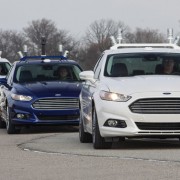Dominique Bonte
There’s been an avalanche of ridesharing announcements from auto OEMs in the last seven months:
- BMW & Scoop– BMW iVentures venture capital arm announced an investment of an undisclosed amount in California-based carpooling service Scoop Technologies.
- Volkswagen & Gett– VW is investing $300 million in Israel-based, low-cost ridesharing player Gett, which is active in more than 60 cities worldwide, including London, Moscow, and New York.
- Toyota & Uber– Mainly a strategic partnership with a MoU to explore cooperation, but Toyota also announced an undisclosed investment from Toyota Financial Services Corporation and Mirai Creation Investment Limited Partnership.
- Apple & Didi Chuxing– Auto OEM in the making? Apple splashing out $1 billion on Uber rival Didi Chuxing (which itself took a stake in Lyft earlier this year).
- GM & Lyft– GM invested $500 million in Lyft, then said it would launch the autonomous Chevy Bolt taxi based on technology from GM-owned Cruise Automation.
- nuTonomy & Ford – Driverless car-sharing company nuTonomy raising $16 million through Ford Chairman Bill Ford.
This starts looking like a gold rush, with major auto OEM brands hurrying to partner with the leading car-sharing initiatives, taking the competition to another level by helping them increase their respective ridesharing market shares.
Clearly, the major automotive brands are afraid to miss the boat on ridesharing. Any remaining independent ridesharing outfit must be looking at this trend, greedily waiting for other car brands to move in.
In the margins of this, the ridesharing paradigm keeps evolving at full speed, either adding functionality like Lyft’s Scheduled Rides or increasing safety, with Uber China testing Face++ facial recognition technology to check driver identification.
At the same time, controversy around the on-demand economy is not expected to calm down any time soon. Local initiatives like non-profit RideAustin trying to fill in the ridesharing void left by Uber and Lyft is testimony to the ongoing legal turmoil.
AUTO OEMS SHIFT TO RIDESHARING
Remarkably, auto OEMs seem to be taking a 180-degree turn: from traditional first-generation car sharing, in which many OEMs have invested by setting up their own operations or JVs in the past years (Daimler car2go, BMW DriveNow, Ford partnering with Zipcar), toward taking stakes in ridesharing ventures.
It seems they finally realize “car sharing 1.0” is not scalable, and instead, must move to “car sharing 2.0,” a.k.a. ridesharing. And they are already looking toward the “car sharing 3.0” era of driverless taxis.
Visit ABI Research for more from Dominique Bonte.
While auto OEMs could still own and control first-generation car sharing, in ridesharing they are relegated to a role of minority investors, which still allows them to have a front row seat to observe the dynamics of the unfolding car-sharing economy.
How serious are auto OEMs about embracing the car-sharing paradigm, killing their own century-old, ownership-based business model? Don’t they still want to sell (more) vehicles?
![Lyft_PressKit_04]() Or, are they starting to understand the ultimate transformative paradigm shift their industry will go through: from business-to-consumer to business-to-business commercial models?
Or, are they starting to understand the ultimate transformative paradigm shift their industry will go through: from business-to-consumer to business-to-business commercial models?
In the future, vehicles will no longer be sold directly to consumers but to fleets of shared, electric, driverless cars. It’s hard to think of a more transformative transition.
It becomes increasingly clear that the high-tech vehicles of the future will only thrive in an automotive industry dominated by on-demand business models.
SMART MOBILITY AS A SERVICE
A never-ending series of consumer surveys keeps pointing out that consumers are not really interested in electric or autonomous vehicles.
What they are interested in is simple: convenient, safe, and affordable transportation. In other words, they want “mobility as a service.” Consumers will embrace electrification and autonomy, not as owners, but as users of seamless ride-hailing services.
It is pointless to position automotive technology with consumers; the focus should be on the service. And it seems this message is finally hitting home in the boardrooms of auto OEMs.
Whether future auto OEMs will run their own car-sharing fleets or sell their vehicles to Uber-like organizations doesn’t really matter.
They will have to exit the consumer car-selling business in both cases, either turning into service organizations or supplying vehicles to third-party mobility providers.
The message for the automotive industry is becoming clear: aim for “smart mobility as a service” and all the (technology) pieces of the puzzle will fall into place. It is possible we have just witnessed the very first evidence of the start of this new era, with Toyota joining forces with Uber.
For more information, visit ABI Research.

